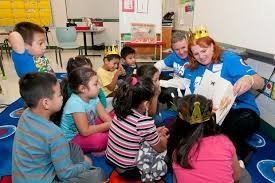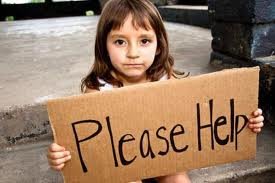Early Childhood Education
OVERVIEW
During their early years, children go through critical stages of development, and consistent, high-quality early childhood education can have long-lasting, beneficial effects on the overall development of children. Research has shown that the early years in a child’s life—when the human brain is forming—represent a critically important window of opportunity to develop a child’s full potential and shape key academic, social, and cognitive skills that determine a child’s success in school and in life.
shape key academic, social, and cognitive skills that determine a child’s success in school and in life.
Early childhood education provides children from all backgrounds with a foundation for school success which generates a significant return on investment for society through a reduced need for spending on other services, such as remedial education, grade repetition, and special education, as well as increased productivity and earnings for these children as adults. It helps to prevent achievement gaps before they start.
 The beginning years of a child’s life are critical for success later in school and in life. Early learning programs can help level the playing field for children from lower-income families on vocabulary, social and emotional development, while helping students to stay on track and stay engaged in the early elementary grades. Children who attend these programs are more likely to do well in school, find good jobs, and succeed in their careers than those who don’t.
The beginning years of a child’s life are critical for success later in school and in life. Early learning programs can help level the playing field for children from lower-income families on vocabulary, social and emotional development, while helping students to stay on track and stay engaged in the early elementary grades. Children who attend these programs are more likely to do well in school, find good jobs, and succeed in their careers than those who don’t.
In her paper, “The Benefits of Early Childhood Education,” Meg Davies said that choosing a preschool in which our child will be loved and cared for is of utmost importance. But it’s also important to select a preschool that will partner with your family to ensure your child’s healthy development throughout his or her early childhood education years.
SOCIAL AND EMOTIONAL DEVELOPMENT
Having your child attend the same preschool program throughout his or her early years allows him or her to develop relationships with the adults and children in that environment, which provides a sense of security. A child who is comfortable with the people in his or her life is more likely to participate in learning opportunities and in advanced cooperative play, such as role playing with others, playing games with rules, and working with others to accomplish goals.
Children who experience consistency in their early childhood education programme demonstrate less aggressive behaviours, because of their ability to interact with others and use their language skills to resolve conflicts. For young children, the knowledge that teachers, other children, and daily routines will be consistent over time fosters confidence and competency in social settings.
Consistency in the preschool program can significantly impact a child’s cognitive development. High-quality early childhood development programs that provide developmentally appropriate curricula, enable children to develop specific cognitive skills at the appropriate age. Developmentally appropriate curricula help children develop cognitive skills through a developmental continuum, meaning the curricula builds on children’s existing skills and knowledge to help them acquire new skills and knowledge. In addition, curriculum programs that incorporate developmental objectives ensure children follow a scope and sequence of age-appropriate developmental milestones throughout their time in the program.
Language Development
 Language development occurs at a rapid pace in children between the ages of one and five years old. Children who are secure in their environment and with the people around them are more likely to engage in frequent, age-appropriate conversations.
Language development occurs at a rapid pace in children between the ages of one and five years old. Children who are secure in their environment and with the people around them are more likely to engage in frequent, age-appropriate conversations.
These daily interactions lead to more advanced language skills by promoting vocabulary development and conversational skills. Through activities such as daily group discussions, finger-plays, songs, and read-aloud, children develop the fundamental language skills they will continue to build on throughout their lifetimes.
s degree in Curriculum and Instruction, Early Childhood Education.
Children of Low-Income Families
Studies show that children from low-income families are less likely to have access to high-quality early education, and less likely to enter school prepared for success. By third grade, children from low-income families who are not reading at grade level are six times less likely to graduate from high school than students who are proficient. Often, the high costs of private preschool and lack of public programs also narrow options for middle-class families.
In her article “Study finds Income-Linked Language Gap” (see below) Motoko Rich talks about a new Stanford research study that is a follow-up to study done twenty years ago that found by age 3, the children of wealthier professionals have heard words millions more times than those of less educated parents. In the new study that age is lowered to as early as 18 months which “gives them a distinct advantage in school and suggests the need to increase investment in prekindergarten programs.”
the children of wealthier professionals have heard words millions more times than those of less educated parents. In the new study that age is lowered to as early as 18 months which “gives them a distinct advantage in school and suggests the need to increase investment in prekindergarten programs.”
By age 2 the study found that affluent children had learned 30% more words than the children in low-income homes. Because professional parents speak so much more to their children, their children hear 30 million more words by the time they are 3. Since oral language and vocabulary are so connected to reading comprehension, the most disadvantaged children face increased challenges once they enter school and start learning to read.
The National Governors Association (NGA) are calling on states to ensure that all children can read proficiently by third grade and urging lawmakers to increase access to high-quality child care and prekindergarten classes and to invest in programs for children from birth through age 5.
“A lot of states are saying, let’s get to the early care providers and get more of them having kids come into kindergarten ready,” said Richard Laine, director of education for the NGA. That way, he said, “We’re not waiting until third grade and saying ‘Oh my gosh, we have so many kids overwhelming our remediation system.”
HEAD START
Launched in 1965 by its creator and first director Jule Sugarman, Head Start was originally conceived as a catch-up summer-school program that would teach low-income children in a few weeks what they needed to know to start kindergarten. Experience showed that six weeks of preschool couldn’t make up for five years of poverty. The Head Start Act of 1981 expanded the program. The program was further revised when it was reauthorized in December, 2007. Head Start is one of the longest-running programs to address systemic poverty in the United States. As of late 2005, more than 22 million pre-school aged children had participated. In 2011 its effectiveness was put into question by a Department of Health and Human Services study. There are long waits to get into early-childhood-enrichment programs like Head Start.
Preschool for All Initiative
Early Head Start-Child Care
President Obama wants Congress to expand access to preschool for every child in America. Beginning at birth and continuing to age 5 the “Preschool for All” initiative will improve quality and expand access to preschool, through a cost sharing partnership with all 50 states, to provide all low- and moderate-income four-year-olds with high-quality preschool, while encouraging states to serve additional four-year-olds from middle-class families.
The initiative also promotes access to full-day kindergarten and high-quality early education programs for children under age four. The goal is to reach all low- and moderate-income four-year olds from families at or below 200% of poverty. The plan is to maintain and build on current Head Start investments, to support a greater share of infants, toddlers, and three-year olds in America’s Head Start centers, while state preschool settings will serve a greater share of four-year olds.
The U.S. Department of Education will allocate dollars (Child Care and Development Block Grants) to states based their share of four-year olds from low- and moderate-income families and funds would be distributed to local school districts and other partner providers to implement the program. This new “Early Head Start-Child Care” partnership will be funded through competitive grants that will support communities that expand the availability of Early Head Start and child care providers that can meet the highest standards of quality for infants and toddlers, serving children from birth through age 3.
The proposal would also include an incentive for states to broaden participation in their public preschool program for additional middle-class families, which states may choose to reach and serve in a variety of ways, such as a sliding-scale arrangement.
The Head Start and Early Head Start programs goal is to reach an additional 61,000 children and enrollment has nearly doubled under this Administration. Needed reform to the program has begun by identifying lower-performing grantees and ensuring that those failing to meet new, rigorous benchmarks face new competition for continued federal funding.
In order to access federal funding, states would be required to meet quality benchmarks that are linked to better outcomes for children, which include:
- State-level standards for early learning
- Qualified teachers for all preschool classrooms
- A plan to implement comprehensive data and assessment systems
Preschool Programs
Preschool programs across the states have to meet common and consistent standards for quality across all programs, including:
- Well-trained teachers, who are paid comparably to K-12 staff
- Small class sizes and low adult to child ratios
- A rigorous curriculum
- Comprehensive health and related services
- Effective evaluation and review of programs
Since only 6 out of 10 of America’s kindergarten students have access to a full day of learning funds under this program may also be used to expand full-day kindergartens that provide rigorous benchmarks and standards once states have provided preschool education to low- and moderate-income four year-olds.
Funds will be awarded through Early Head Start on a competitive basis to enhance and support early learning settings; provide new, full-day, comprehensive services that meet the needs of working families; and prepare children for the transition into preschool. This strategy – combined with an expansion of publicly funded preschool education for four-year olds – will ensure a cohesive and well-aligned system of early learning for children from birth to age five.
The Evidence-based Home Visiting Initiative
The Administration’s “Evidence-based Home Visiting Initiative,” through which states are implementing voluntary programs that provide nurses, social workers, and other professionals to meet with at-risk families in their homes and connect them to assistance that impacts a child’s health, development, and ability to learn is proposing to expand.
Obama has already committed $1.5 billion to expand home visitation to hundreds of thousands of America’s most vulnerable children and families in all 50 states. The President will pursue substantial investments to expand these important programs to reach additional families in need.
These programs have been critical in improving maternal and child health outcomes in the early years, leaving long-lasting, positive impacts on parenting skills; children’s cognitive, language, and social-emotional development; and school readiness. This will help ensure that our most vulnerable Americans are on track from birth, and that later educational investments rest upon a strong foundation.
Race to the Top – Early Learning Challenge
The Early Learning Challenge has rewarded 14 states that have agreed to raise the bar on the quality of their early childhood education programs, establish higher standards across programs and provide critical links with health, nutrition, mental health, and family support for our neediest children.
Challenges
President Obama has been a steadfast supporter of Head Start and Early Head Start. However, pressure to resolve our nation’s economic problems is growing, and the President and members of his administration will be forced to make difficult decisions about how to spend federal dollars. Many are against federal spending on programs for our most vulnerable children and their families. There have been calls for ending Head Start, arguing that its positive effects fade away after a few months.
Another important challenge is appropriate pay for Early Childhood Education instructors. In a recent survey of starting pay for college graduate professions engineering (mechanical, computer, etc.) was at the top at $58,000 per year while Early Learning instructors pay was one of lowest at $34,000 per year. What we pay Early Childhood Education instructors now will save millions later.


Recent Comments